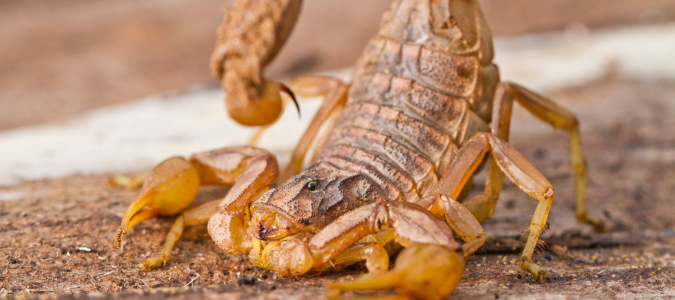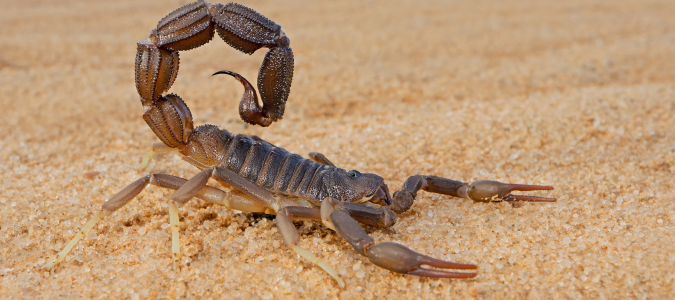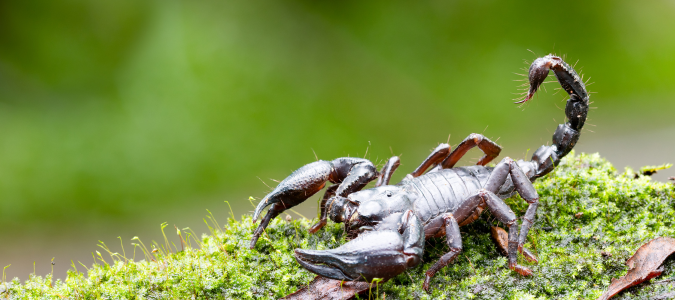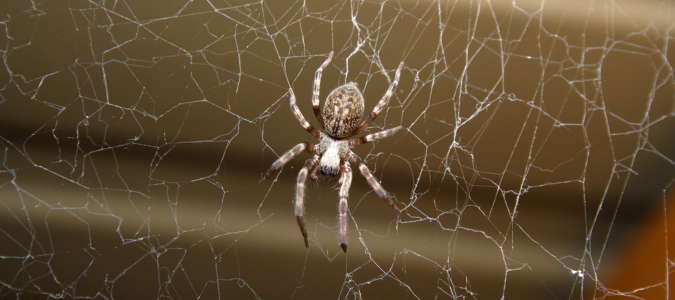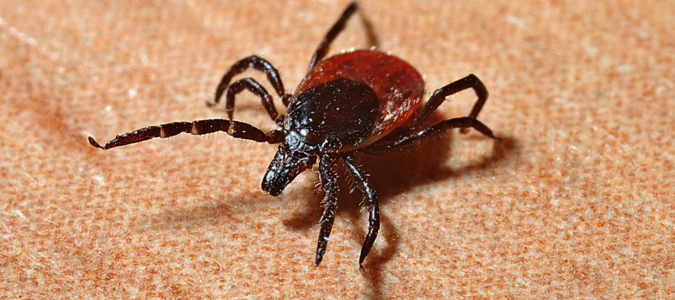If spiders make you jump and your hairs stand on end, you won’t like their cousin, the scorpion. Armed with claws and a stinger, scorpions scare many homeowners. With around 50 species living in the US, you may spot one of these creepy crawlies wandering around your home.
The good news is most scorpion species are harmless to humans. However, their stings are still painful. Contact pest control professionals if you see this arachnid in your home. That way, the experts can manage the scorpion population on your property. Aside from scorpions, pest control specialists also know how to deal with other creepy crawlies like the southern house spider .
Here’s How to Identify Scorpions
Scorpions look like lobsters and crabs because they belong to the same group, Phylum Arthropoda. However, not many people know that scorpions have even closer ties to spiders, belonging to the same subgroup Arachnida. It may not be obvious, but scorpions and spiders share many physical traits, including leg count. So, how many legs do scorpions have? They have eight legs, like spiders and other arachnids like mites and ticks.
A scorpion’s four pairs of legs are attached to its cephalothorax and play a crucial role in navigation. Their legs have brush-like sensory structures called pectines, which can detect vibrations. Scorpions use them to feel their way through their surroundings and catch their next meal. These hairs can sense vibrations from prey as far as a foot away. Male scorpions also depend on their pectines to find a suitable mate, while babies need them to recognize their mother.
Aside from their eight legs, scorpions have other physical traits that set them apart from insects. They have a long, segmented body with two regions: the cephalothorax and the metasoma. The cephalothorax houses all the scorpion’s locomotion, feeding and sensory parts, including the following.
Two Pairs of Chelicerae
These mouthparts are on either side of the mouth. They allow scorpions to tear their prey apart as they’re feeding.
Pedipalps
These enormous pincers are as sensitive as antennae and have the dexterity of a hand. Scorpions use them to lock down their prey as they devour them. They are also used to hold partners during elaborate mating dances.
Four Pairs of Jointed Legs
Covered in sensory hairs, scorpions use their legs to explore, detect prey and find a mate.
Eyes
Scorpions have a pair of median eyes and several lateral ones. Despite having plenty of eyes, they don’t have the best vision.
Metasoma
Meanwhile, the metasoma is the scorpion’s “tail.” However, it’s not a true tail but rather an extension of the abdomen. It has five segments, each longer than the last, and ends with the telson or stinger. Scorpions use their stingers to subdue their prey or as a defense against predators. In some cases, that predator can be an unknown human foot.
Scorpions only use their venomous sting when necessary. They expend significant energy to produce their venom, so they’re careful not to waste it. That’s great news for homeowners who are terrified of these creepy crawlies.
While they’re mostly harmless, you don’t want scorpions breeding on your property and giving you jump scares. Contact pest control specialists if you spot one in your home or on your property. They will put measures in place to manage the scorpion population on your property and keep them from disturbing your peace. These experts also know how to deal with other pest problems you may have at home, including small black ticks .
What is the Lifespan of a Scorpion?
If you have scorpions on your property, you might wonder how long they’ll hang around. Unfortunately, these creatures are slow growers, taking between one and six years to mature, depending on the species. They have an average lifespan of three to five years, but some species can stick around for as long as 15 years. That means you’ll be sharing your space with them for a long time if you don’t take measures to control them.
Adult scorpions can have multiple broods of babies. After their complex mating ritual that typically lasts between 24 and 36 hours, the female enters a gestation period. This can go on for five months to an entire year. Then, it will give birth, and their young will initially live wrapped inside semi-transparent sacs. Once their babies break free, they will climb aboard their mother’s back and stay there for about two weeks. By then, they can sting on their own and fend for themselves. One female produces 25 to 35 babies, so you can only imagine how quickly an infestation can happen.
What Attracts Scorpions?
So, what draws scorpions to our homes? When scorpions enter our residences, that usually means there’s a disruption in their habitat, causing them to seek moisture, food and shelter elsewhere. They can easily slip into our homes through cracks and crevices. As dry-land creatures, scorpions don’t typically like damp areas. However, they need moisture to survive, so they hang out in bathrooms and kitchens. You might also find them in attics, crawl spaces and wall voids.
Scorpions usually migrate indoors in late spring to early summer to avoid the rain. As temperatures soar in the summer, they’ll move to the colder parts of your home. If you’d rather not share your space with these creepy crawlies, here are some ways you can deter them:
- Use sealant around pipes, roof eaves and other gaps in your home’s structure to eliminate possible entryways.
- Seal off weep holes with copper mesh, steel wool, screen wire or nylon scouring pad.
- Use weatherstripping for loose-fitting windows and doors.
- Install window screens, ensuring they fit snugly around the frames. Repair them immediately if they develop holes.
- Mow the grass around your home’s structure regularly. In addition, prune back bushes and overhanging tree branches to eliminate pathways to the roof.
- Remove logs, bricks, trash, boards and other items around your home’s structure and place them somewhere further away.
- Avoid bringing firewood into your home unless you’re ready to place them in the fire.
- Keep your garbage cans away from the ground by placing them on frames.
While these measures can deter scorpions from entering your home, what do you do if they’re already in your space? That’s the time to contact pest control professionals. They have the tools and expertise to treat your home and keep these creatures in check. They can also return for regular maintenance checks to help prevent future infestations. These professionals can also answer other pest-related questions like ” How long can ticks live in a house? “
Is a Scorpion an Insect or a Spider?
Scorpions are odd-looking creatures, making many question what they are exactly. Are they insects or spiders? The answer is none of the above. Scorpions are arachnids, putting them in the same family as spiders. You can think of scorpions and spiders as cousins but they shouldn’t be confused for each other. Ticks and mites are other members of the class Arachnida.
All arachnids are characterized by their two body regions, four pairs of legs and two pairs of mouthparts. However, they have distinct characteristics that set them apart from each other.
Here’s how to tell scorpions apart from their fellow arachnids.
Scorpions
Scorpions, pictured above, are the largest members of the class Arachnida. Aside from their size, these other features make them look extra menacing: ginormous pedipalps that look like claws and stingers at the end of their abdomen. They’re opportunistic predators that feast on any small animal they can get their pedipalps on, including insects and spiders.
Spiders
Like scorpions, spiders, pictured above, have a cephalothorax and abdomen. However, a narrow pedicel connects these two regions. They also have eight legs, although their pedipalps may look like an extra pair. Spiders come in a variety of sizes, some as small as a pinhead, while others have legs as long as 12 inches.
Ticks and Mites
Ticks, pictured above, and mites are the smaller members of the class Arachnida. Their oval bodies offer little distinction between the cephalothorax and abdomen. While their young only have three pairs of legs, they develop an additional pair after molting for the first time. That brings their total leg count to eight.
Let a pest control specialist come to the rescue if you’re dealing with scorpions at home. While they’re generally harmless, they won’t hesitate to sting you if you provoke them. Spare yourself the pain and let the pros handle the situation.
Leave Your Pest Problems to the Professionals
You don’t have to face scorpions on your own. If you can’t stand the sight of them, let pest control specialists take over. They will handle these clawed creatures and restore the peace in your home.
ABC Can Reduce the Number of Scorpions on Your Property
Finding scorpions around your property can be concerning. You can feel more comfortable by contacting ABC Home & Commercial Services. Our pros create custom pest control solutions, so you don’t have to worry about so many scorpions.
